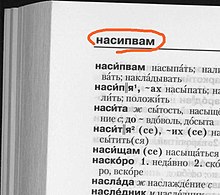In typography and word processing, a page header (or simply header) is text that is separated from the body text and appears at the top of a printed page. Word-processing programs usually allow for the configuration of page headers, which are typically identical throughout a work except in aspects such as page numbers.

The counterpart at the bottom of the page is called a page footer (or simply footer); its content is typically similar and often complementary to that of the page header.
In publishing and certain types of academic writing, a running head, less often called a running header, running headline or running title, is a header that appears on each standard page.[1] Running heads do not usually appear on display pages such as title pages, or on other front or back matter.[2] Running heads in a book typically consist of the title on the left-hand (verso) page, and the chapter title on the right-hand (recto) page; or the chapter title on the verso and subsection title/subhead on the recto, aiding the reader's navigation by showing what content exists within the two-page spread at hand.
A special case of the latter is in dictionaries, whose running heads are called guide words; they show the first headword and last headword on each page, to expedite the reader's navigation to a desired headword. In academic writing, the running head usually contains the page number along with the author's last name,[3] or an abbreviated version of the title.[4] The counterpart of the running head is the running foot.
-
Header with highlighted current chapter title
-
Header with the author's name and pagination
-
Header placed on the left hand side of page
-
Header placed on the left hand side of page, pothi format
See also
editReferences
edit- ^ "Running head". WordNet. Princeton University.
- ^ "How to Design Running Heads for Your Book". The Book Designer. 2014-03-31. Retrieved 2018-03-12.
Running heads are never used on display pages such as the title, half title, chapter- and part-opening pages. They aren't used on "matter" opening pages, like the first page of the Preface or the first page of the Table of Contents. Running heads are also omitted on pages that have only an illustration or a table on them. On the other hand, if there is any text at all, even one line, then running heads should appear on the page. If an entire section or run of pages contains only illustrations, running heads can be used to help orient the reader.
- ^ Gibaldi, Joseph (2009). MLA handbook for writers of research papers (7th ed.). New York: Modern Language Association of America. pp. 117–118. ISBN 978-1-60329-024-1.
- ^ Publication Manual of the American Psychological Association (6th ed.). Washington: American Psychological Association. 2010. ISBN 978-1-4338-0561-5.




